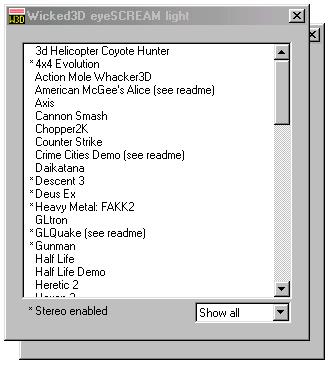
Metabyte Wicked3D eyeSCREAM light
Universal OpenGL Game Driver for Red-Blue-Anaglyph-3D-Glasses
Review by Christoph Bungert
Page introduced on April 28, 2001
last update:
related links:
Wicked3D
D.I.S.T. (european/german distributor)
MMS-Computer (german distributor)
Gamebasics
Rainbow Symphony
(glasses distributor)
E3D Media Group
(glasses distributor)
eyeSCREAM light by Wicked3D is a program which sits between an OpenGL game and the graphics-driver to provide stereoscopic 3D-vision utilizing inexpensive red-blue 3D-glasses. It's a descendant of the well known eyeSCREAM driver for 3D-shutterglasses. There is a free demo version available.
The purpose of this software should be to give a larger audience a chance to experience stereoscopy without the expenses and hassles of installing electronic 3D-shutterglasses or headsets.
The installation process is very easy and the driver works stable. All tested games showed very good stereo-effects.
It has to be said however that stereo-quality in OpenGL was never an issue. Even the very first generation of the Wicked3D universal driver for shutterglasses managed this quite fine. In Direct3D it wasn't so easy in the beginning and some drivers are still immature in this area. The D3D problem was best solved by ELSA in their Revelator driver. EyeSCREAM light however avoids this issue completely. There seems to be no Direct3D-support at all. Nevertheless I was surprised by the rather long list of supported games.


The setup shows all supported games. The titles which were found on the users harddrive are marked with an * and can be played in stereo right away. (In this case 15 titles were found on my HD). In all cases the retail and the demo version of a game seems to be supported.
The games are devided into 2 groups: certified and uncertified. The certified titles work more or less flawlessly, while the others may show irregularities like objects placed on the wrong depth layer and so forth.
eyeSCREAM light has no hotkeys and no user changeable stereo-options,
apart from effect strength (parallax) in 4 steps (25, 50, 75, 100 %).
The software scans the harddisc for compatible games and enables stereo
for them. This is a really painless process and stereo can easily be deactivated
again. eyeSCREAM light seems also to co-exists well with shutterglasses
drivers when deactivated.
Like in the shutterglasses version there are 3D aiming helps, including a virtual laser pointer, which works great and is far superior to standard aiming.
Colors and Effects
The images provided by eyeSCREAM light are not just red/blue, they provide
some perception of color. The color information is mainly provided through
the blue-lens. By managing to concentrate on the 'blue-eye' one can see
almost normal colors.
The effect strenght (parallax) is rather high. I don't think anyone
has to use a setting above 50% to get a kick out of it. In any case the
best way to go is to relax the eyes, just as if you would look at an autostereogram
(these Magic-Eye type random dot 3D-images).
Anaglyph vs. Shutterglasses
Apart from the lower price anaglyph even has some advantages over shutterglasses.
A major point is the compatibility of anaglyph glasses with all display
technologies, including LCD, DLP, D-ILA and Plasma, while shutterglasses
only support CRT-monitors and projectors.
Furthermore there is no additional flicker and both eyes see the images
simultaneously, while with shutterglasses one eye is always blacked out.
The brain is just fooled by the high frequency in which this sequential
switching happens. The feeling with red-blue glasses is different and somewhat
better in this respect. Shutterglasses remain superior though, mainly due
to the capability to show full, natural colors for both eyes.
A major advantage of anaglyph over
Demo version vs. retail version
The demo version works for an unlimited time, but only supports 2 game titles: Quake3 and 4x4 Evolution.
The retail version costs US$ 15, comes with 2 pairs of cardboard red-blue glasses and supports almost all OpenGL games under Windows 95/98/ME.
VGA-boards supported by eyeSCREAMlight v1.02:
- 3dfx Voodoo4/Voodoo5
- ATI Rage 128/Rage 128 Pro/Radeon
- NVIDIA TNT/TNT2/GeForce/GeForce2
- Matrox G400/G450
Configuration and titles used for testing:
- eyeSCREAM light retail version 1.02
- GeForce256 under Windows 98
- latest NVidia reference driver
- 4x4 Evolution Demo
- GLQuake
- Gunmen Chronicles Demo
- Quake 3
- MDK2 Demo (loading was very slow, 3D aiming help didn't work correctly)
- Serious Sam Demo
- Tuxracer
All games ran stable and with great stereo-effects.
Wish list for future updates:
- Direct3D support
- In-game hotkeys for stereo-separation, stereo-on/off, anaglyph-screenshot
and gamma
- user definable settings, ability for the user to add titles
- color-calibration
Conclusion
A very interesting product which is important for the 3D-market! It reminds me of the way things started for me. In 1994 Magic Carpet by Peter Molineux (Black & White) came out which had a fantastic red-blue stereo-mode. I was thrilled and the prospect of being able to see these kind of effects in full color made me pay $200 for my first pair of shutterglasses. eyeSCREAM light provides stereo-effects which are comparable in quality to such native-anaglyph titles.
Just get it, at least the eyeSCREAM light demo and the 4x4 Evolution demo.
Let's hope eyeSCREAM light will stimulate peoples appetite for stereo3d.
Brand and product names are trademarks or registered trademarks of their
respective holders.
The text is the
intellectual property of the author.
Don't copy any part
without credit and link to this site!

